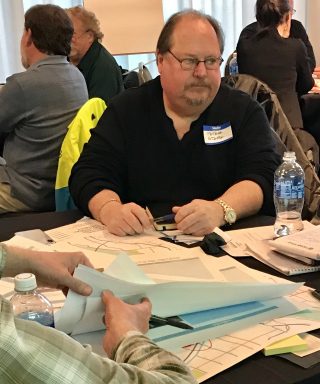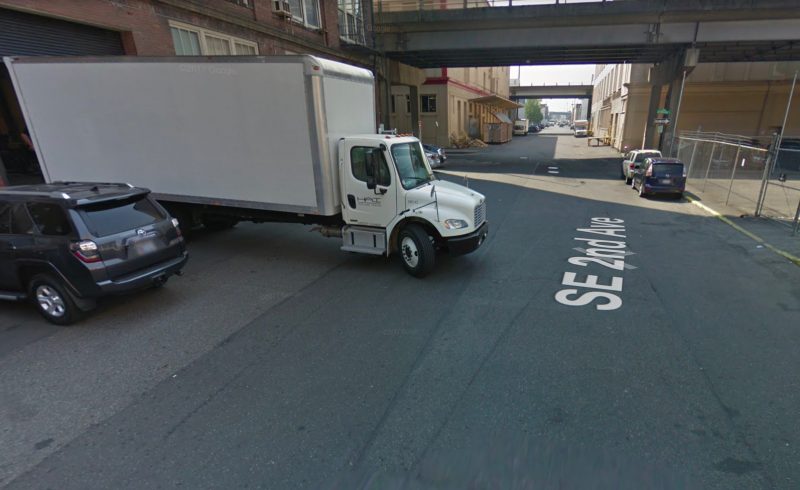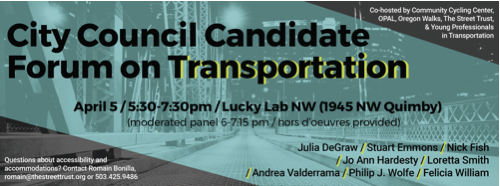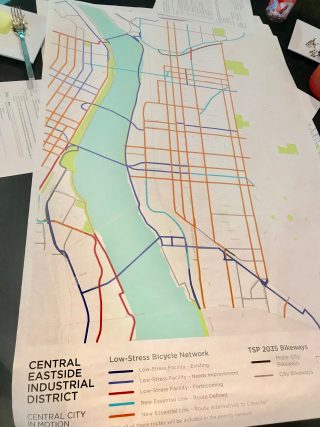
Peter Stark at a Central City in Motion project design charrette on March 16th.
(Photo: J. Maus/BikePortland)
As the City of Portland looks to create a usable, low-stress cycling network in the central city, one of the toughest places to make it a reality will be the Central Eastside Industrial District. An area hemmed in by massive freeway infrastructure with a legacy of heavy industry and freight-dependent businesses, the CEID is in many ways the lynchpin of the Central City in Motion project.
One of the people standing in the middle of discussions about how to plan for the future of this district is Peter Stark.
Stark is a licensed architect who owns his own design and planning firm. He’s also one of Portland’s most well-known activists. Stark’s many civic endeavors include a position on the board of Portland Streetcar Inc., and he’s the founder and board chair of the Cornell Road Sustainability Coalition. In the Central Eastside, Stark has been a key player for over 17 years. He’s a past president of the Central Eastside Industrial Council and currently on the board as well as being the executive director of the CEIC’s Transportation Policy Advisory Committee.
I caught up with Stark after a meeting of the Central City in Motion in project last week to ask him about how he sees the future of bikes and freight in the Central Eastside.

Typical scene in the Central Eastside, where the streets often feel like bikers and walkers aren’t welcome.
How are you feeling at this point about the City’s plans for improving bikeways in the CEIC?
“We’ve said from the very beginning we are strong supporters of improved bicycle and pedestrian movement in the city because we realize we have limited capacity for freight. We need to open up the roads for better freight movement. So providing an opportunity for people to get out of their cars and use these other systems, is a big benefit for us. Anbd we have many employees that love to get to their jobs through those facilities. The problem we’ve had is that, and the city doesn’t understand this, it when it comes to freight what we’re really worried about is hurting people. So I keep pushing the idea that we ought to have dedicated alignments for those uses [freight and bicycles] so we don’t have a conflict. The minute you put them on the same road it’s always a question of, what happens when somebody gets killed?”
What about the contention that the district is changing. The CEIC says freight is so important today, but what about five years from now?
“As we continue to densify and increase employment, you’re going to have more freight, not less. They’ll be smaller, but you’ll have more delivery, more needs to move goods and services in and out.”
You’re talking about freight delivery. But what about the industrial land-use? Isn’t that changing?
“Yes and no. Talk to New Seasons, they just made a substantial investment here in the district. And they are freight-centric. This is a distribution center for them. You’ve got a lot of companies that have really invested in this district. Now, you can kick them out and maybe eventually they’ll find they can’t move [their goods] in or out. But I’ve always believed you want to evolve the district, rather than just cut it off. I try to move the district towards little changes. A little bit at a time.”
You say it’s a freight and industrial district for the next 10-20 yrs, and the City says it also has to be a place to move vulnerable people safely through the streets. Is there a way to make these things coexist?
“Yes, but it doesn’t mean you put those people on the same road as the roads that have been desginated as freight. SE 7th is a good example. I’ve been working with Ryan [Hashagen, of Icicle Tricycles] and Franklin [Jones, of B-Line Urban Delivery] for quite a few years and they’re a bicycle business that moves goods and services. They can be on those freight streets because they understand the importance of mixing safely. But when you see that slide [referring to a PBOT slide in the meeting] with that little kid with her mom and her groceries on the back — and you put that on a street where you have freight — that’s asking for disaster. And I’m worried about it.”
So you want separate streets for bike and freight. Then the question becomes, which mode gets which streets?
“Well, 7th hasn’t always been a bike alignment. The city seems to always put bike alignments on some of the major arterials. You look at a street where there’s a sharrow and you’ve got a bike in a neighobhrood… A lot of your little kids are going to use that street over a bike lane that’s been painted on the ground next to a big truck that’s coming by. Again, and I’m just worried that we haven’t talked about it enough, but MLK/Grand Avenue is our corridor. I would love to see us slow the traffic down there, make that our commercial corridor; put the Green Loop right on our commercial corridor [the Green Loop is currently planned to be on 6th and 7th].”
Do you feel the same way about parking? That the City’s plans for biking can coexist with existing parking capacity?
“When you talk about transitions and increased density. Think of it in terms of increased employment density and not just residential. That’s the model in the Central Eastside. It’s not a mixed-use district as much as it’s focused on increasing employement. The reason we’ve been pushing this industrial model – and by the way we all know it’s really a new urban-industrial-hybrid-creative-services kind of a thing, not smokestacks — the truth is, parking is going to continue to be going away. There’s no way of avoiding it. We’ve got to provide solutions that provide for the employment increase transitionally. So we’re going to continue to fight to save parking if we can, and realize that over time it will go away. It’s inevitable. It will probably become freight loading and unloading.”
Or maybe it’ll become space for protected bike lanes?
“Or both! I think we have more in common with the bike community than less. We have more interests that are the same than not. Finding a solution is what we’re hoping to be able to do.”
— Jonathan Maus: (503) 706-8804, @jonathan_maus on Twitter and jonathan@bikeportland.org
Never miss a story. Sign-up for the daily BP Headlines email.
BikePortland needs your support.
The post Freight, bikes, and the Central Eastside: An interview with Peter Stark appeared first on BikePortland.org.
from Latest headlines from BikePortland https://ift.tt/2HWr11y



No comments:
Post a Comment